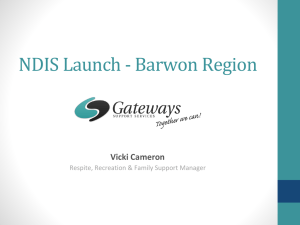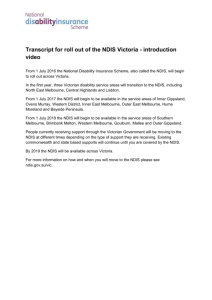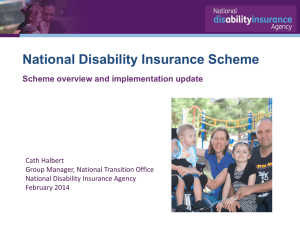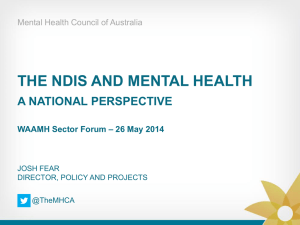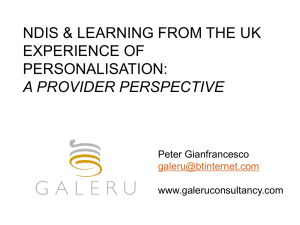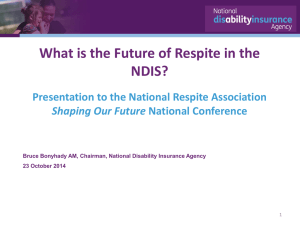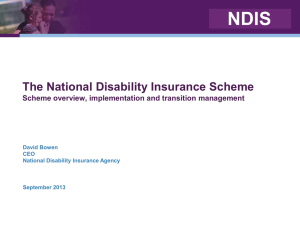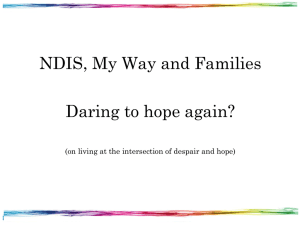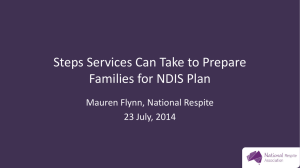Power point slide presentation
advertisement
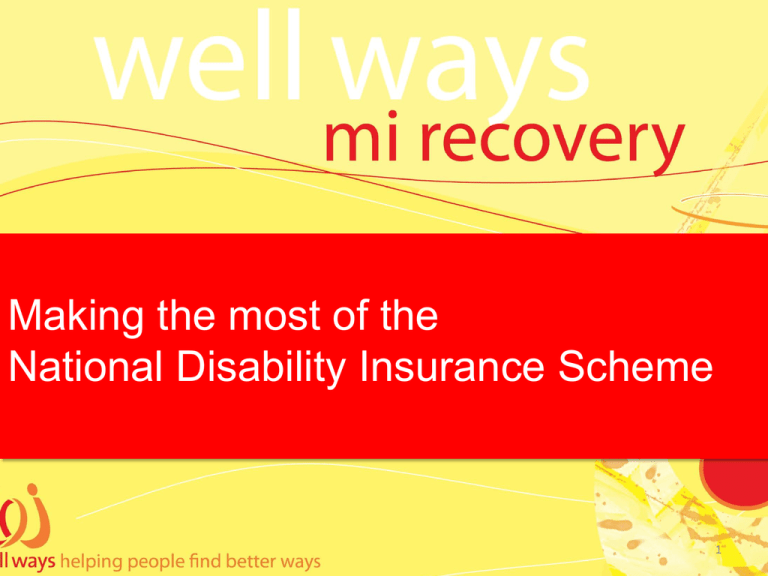
Making the most of the National Disability Insurance Scheme 1 Workshop Overview Aim: To develop an understanding of the proposed National Disability Insurance Scheme (NDIS) and develop an awareness of how to effectively access the scheme. Objectives: •To gain an understanding of the why the NDIS is being developed •To gain an understanding of what the NDIS entails •To develop awareness of how to effectively access the NDIS to ensure it best meets personal recovery objectives and movement towards life goals. •Identify supports and resources 2 Workshop Overview Unit 1: Introduction to the NDIS Welcome and Introductions Workshop overview Introduction to the NDIS The current recovery oriented system The recovery oriented system under NDIS What impact will the NDIS have on service provision What can be expected from the NDIS BREAK 15 Minutes Unit 2: Effectively engaging with the NDIS Effectively engaging with the NDIS Consumer power Preparing for NDIS assessments Wrap up 3 What is the National Disability Insurance Scheme •Universal health care scheme •It is a scheme that has been implemented in other countries in the world (eg Scotland) successfully and will be implemented here in Australia over the next few years. •There are many details of the NDIS to still work out •Focuses on those who are most in need who have a permanent disability •Focuses on intensive early intervention • The NDIS will be launched at 4 trial sites in mid 2013. 4 The current model of recovery services 5 Types of services/activities offered in Psychiatric Disability Support Services and Carer Respite Services •Supported accommodation •Community activities •Learning activities •Socialising activities •Sporting activities •Employment support •Housing support •Group learning •Family education •Personal development/recovery group learning •Breaks away from caring roles 6 The NDIS model of service 1. Referral to DisabilityCare Australia 2. Assessment by DisabilityCare Australia • Assessment of eligibility 3. Planning and choosing services and support • Form a plan of what the person wants and needs to achieve independence • Must be ‘reasonable and necessary’ • Establish an individual budget based on the plan • Identify and access services and supports with Local Area Coordinator 4. Review process • Review outcomes of support • Changes made as needed 7 Features of the NDIS model Features of this model include: •Individuals can decide what types of services they need •Not confined to services provided within a given area •Choice of services from mainstream providers •Culturally appropriate, religiously appropriate 8 Current and NDIS service delivery Current system Individuals can choose from the services that are offered within the local PDRS services and Commonwealth Respite Service for families catchment area bound NDIS system Individuals can decide what types of services they need and from a broader range of services Individuals are not confined to services provided within a given area Services are funded to provide a Individuals are not confined to services certain number of hours of service provided within a given area The types of services that are available Individuals have the option of seeking don’t necessarily suit everyone services from mainstream providers Not many services have catered to the Individuals will be able to choose to needs of people from diverse cultures, purchase what they need from ethnoreligious groups, varying sexuality specific services and those who cater to the needs of different religions and 9 sexualities The NDIS environment will require services to: •Increased outcome focus evaluation •Increased evidence based interventions •More quality assurance mechanisms •More liaison with family •More assessment and servicing of families •More use of cultural appropriateness •More appropriate servicing of the lesbian, gay, bisexual and intersex community •More religious appropriateness 10 What does ‘reasonable’ and ‘necessary’ mean Supports and services; •Should support the individual to achieve their goals and maximize their independence •Should support the individual’s capacity to undertake activities of daily living to enable them to participate in the community and/or employment •Are effective, and evidence informed •Offer value for money •Should reflect community expectations, including what is realistic to expect from the individual, families and carers •Are best provided through an NDIS rather than through other systems of service delivery and support 11 BREAK 12 . How can I ensure that the NDIS operates as a self-directed support model? by.... •Knowing what helps me manage my illness •Knowing what I want from life and what I need so that I can reach my goals •Being knowledgeable about evidence that can justify my NDIS service preferences •Being empowered to communicate my choices well •Knowing who can support or advocate with me to negotiate for the services I need and help me to reach my goals “I can be in the driver’s seat of my recovery and life – not the backseat or the boot!” 13 Current and NDIS service delivery Current system Individuals can choose from the services that are offered within the local PDRS services and Commonwealth Respite Service for families catchment area bound NDIS system Individuals can decide what types of services they need and from a broader range of services Individuals are not confined to services provided within a given area Services are funded to provide a Individuals are not confined to services certain number of hours of service provided within a given area The types of services that are available Individuals have the option of seeking don’t necessarily suit everyone services from mainstream providers Not many services have catered to the Individuals will be able to choose to needs of people from diverse cultures, purchase what they need from ethnoreligious groups, varying sexuality specific services and those who cater to the needs of different religions and 14 sexualities Wrap up 15
